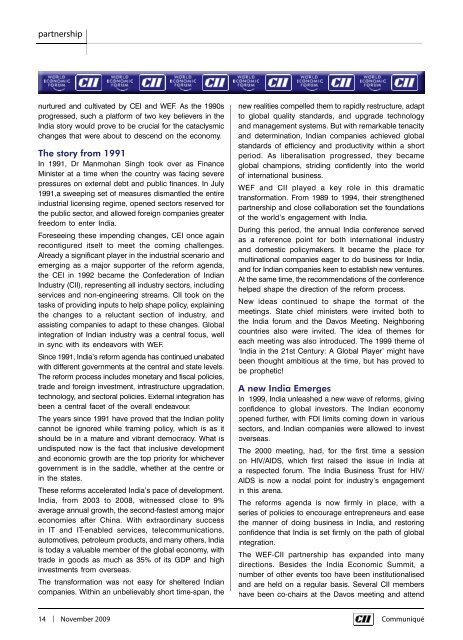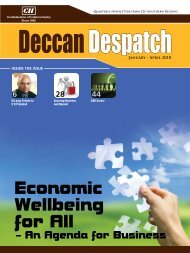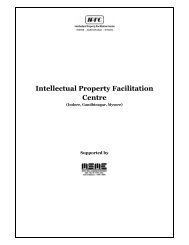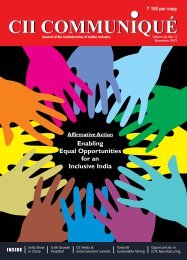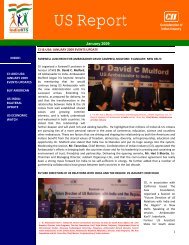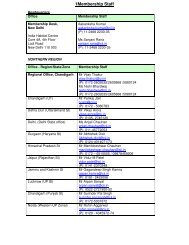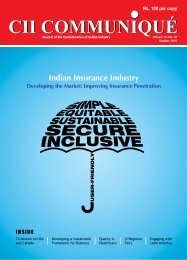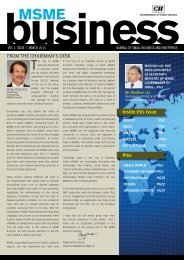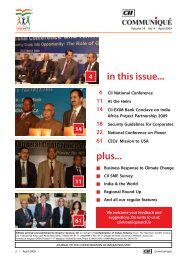Communiqué November 2009 | 1 - CII
Communiqué November 2009 | 1 - CII
Communiqué November 2009 | 1 - CII
- No tags were found...
You also want an ePaper? Increase the reach of your titles
YUMPU automatically turns print PDFs into web optimized ePapers that Google loves.
partnershipnurtured and cultivated by CEI and WEF. As the 1990sprogressed, such a platform of two key believers in theIndia story would prove to be crucial for the cataclysmicchanges that were about to descend on the economy.The story from 1991In 1991, Dr Manmohan Singh took over as FinanceMinister at a time when the country was facing severepressures on external debt and public finances. In July1991,a sweeping set of measures dismantled the entireindustrial licensing regime, opened sectors reserved forthe public sector, and allowed foreign companies greaterfreedom to enter India.Foreseeing these impending changes, CEI once againreconfigured itself to meet the coming challenges.Already a significant player in the industrial scenario andemerging as a major supporter of the reform agenda,the CEI in 1992 became the Confederation of IndianIndustry (<strong>CII</strong>), representing all industry sectors, includingservices and non-engineering streams. <strong>CII</strong> took on thetasks of providing inputs to help shape policy, explainingthe changes to a reluctant section of industry, andassisting companies to adapt to these changes. Globalintegration of Indian industry was a central focus, wellin sync with its endeavors with WEF.Since 1991, India’s reform agenda has continued unabatedwith different governments at the central and state levels.The reform process includes monetary and fiscal policies,trade and foreign investment, infrastructure upgradation,technology, and sectoral policies. External integration hasbeen a central facet of the overall endeavour.The years since 1991 have proved that the Indian politycannot be ignored while framing policy, which is as itshould be in a mature and vibrant democracy. What isundisputed now is the fact that inclusive developmentand economic growth are the top priority for whichevergovernment is in the saddle, whether at the centre orin the states.These reforms accelerated India’s pace of development.India, from 2003 to 2008, witnessed close to 9%average annual growth, the second-fastest among majoreconomies after China. With extraordinary successin IT and IT-enabled services, telecommunications,automotives, petroleum products, and many others, Indiais today a valuable member of the global economy, withtrade in goods as much as 35% of its GDP and highinvestments from overseas.The transformation was not easy for sheltered Indiancompanies. Within an unbelievably short time-span, thenew realities compelled them to rapidly restructure, adaptto global quality standards, and upgrade technologyand management systems. But with remarkable tenacityand determination, Indian companies achieved globalstandards of efficiency and productivity within a shortperiod. As liberalisation progressed, they becameglobal champions, striding confidently into the worldof international business.WEF and <strong>CII</strong> played a key role in this dramatictransformation. From 1989 to 1994, their strengthenedpartnership and close collaboration set the foundationsof the world’s engagement with India.During this period, the annual India conference servedas a reference point for both international industryand domestic policymakers. It became the place formultinational companies eager to do business for India,and for Indian companies keen to establish new ventures.At the same time, the recommendations of the conferencehelped shape the direction of the reform process.New ideas continued to shape the format of themeetings. State chief ministers were invited both tothe India forum and the Davos Meeting. Neighboringcountries also were invited. The idea of themes foreach meeting was also introduced. The 1999 theme of‘India in the 21st Century: A Global Player’ might havebeen thought ambitious at the time, but has proved tobe prophetic!A new India EmergesIn 1999, India unleashed a new wave of reforms, givingconfidence to global investors. The Indian economyopened further, with FDI limits coming down in varioussectors, and Indian companies were allowed to investoverseas.The 2000 meeting, had, for the first time a sessionon HIV/AIDS, which first raised the issue in India ata respected forum. The India Business Trust for HIV/AIDS is now a nodal point for industry’s engagementin this arena.The reforms agenda is now firmly in place, with aseries of policies to encourage entrepreneurs and easethe manner of doing business in India, and restoringconfidence that India is set firmly on the path of globalintegration.The WEF-<strong>CII</strong> partnership has expanded into manydirections. Besides the India Economic Summit, anumber of other events too have been institutionalisedand are held on a regular basis. Several <strong>CII</strong> membershave been co-chairs at the Davos meeting and attend14 | <strong>November</strong> <strong>2009</strong> Communiqué


